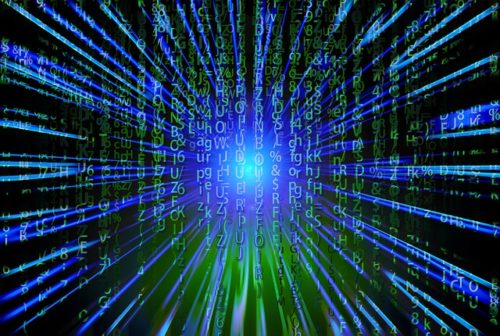TWH – Cyberspace. Janus-like, Techno-Paganism has one face looking forward toward cyberspace. Its other face looks backward toward ancient, intact Pagan cultures, as with many other Pagan approaches. Recently The Wild Hunt spoke with Maat of the JaguarMoon, a teaching and working coven, about Techno-Paganism. She also writes for the website CyberCoven.org.

[pixabay].
Maat described JaguarMoon’s practice as eclectic. She said that an eclectic approach fits better with Techno-Paganism or cyber- covenry. That approach allows for more pushing of boundaries and exploring of possibilities.
Inclusivity
JaguarMoon has issued an inclusivity statement. According to Maat, no internal incident drove the writing of this statement. She said it arose from “recent discussions among magical groups.” She felt “it was no longer sufficient to say we follow the Rede (Harm none) and be considered safe space.”
This statement rejected “racism, sexism, ageism, homophobia, ableism, sizeism, jingoism, classism, and transphobia.” It stated that “any act that takes place between consenting adults is beautiful. There is no shame in any body type, physical expression, disability, or adornment.” It stressed personal sovereignty.
While people with a high need for face-to-face contact would find techno-Paganism unattractive, others might find the experience, with its unique boundaries and allowances, very attractive. For example, many Pagan events occur in the “great outdoors.” This often creates access problems for the housebound, people with mobility issues, and people without cars or other means to get to the location. Techno-Paganism can serve such people.
Unlike a face-to-face coven, a virtual coven lacks a requirement for geographic proximity or travel. A virtual coven can draw members from anywhere with Internet connections. JaguarMoon’s members have lived in Germany, Japan, Martinique, the UK, and the US, said Ma’at. Geographically isolated people would also find Techno-Paganism attractive.
Maat estimated the demographics of JaguarMoon participants over the years. About 90 percent have been white and 95 percent female. About 20 percent identified as LGBT or Queer. She also estimated that about 80 percent of participants belonged to Generation X, Y, or Z.
What is Techno-Paganism or cyber-covenry?
Maat defined a cyber coven as an earth based spiritual practice that primarily or exclusively meets in cyberspace. She described cyberspace as a “technological doorway to the astral plane.” Inert computer hardware and software will not open that doorway unless the coven activates them through ritual.
At first, this may be confusing to people, she explains. Most people have only a minimal understanding of how their computers or cell phones work. “For a cyberwitch, this lack of direct knowledge makes the process of writing a letter on the computer a potentially magickal experience. The logic of technology has become invisible – literally, occult.”
Maat reported that the energy in cyberspace differs from that in face-to-face ritual. “A physical circle can more easily raise energy through chanting, dancing, drumming, etc.” She continued, “Cyber rituals raise energy, but it’s usually not as intense. Cyber ritual requires active participation. You can get ‘swept up’ in physical ritual energies even if you’re not actively engaging in the process. Virtually, if you don’t participate you don’t get caught up. It’s just like watching TV.”
Visualization has more importance in cyber space ritual than in face-to-face ritual. In face-to-face ritual, people hand things to one another. They move through the same physical environment. In cyber space, people must visualize all that. According to Maat, “Visualization skills are mandatory!” Another crucial skill involves trance work. Almost every ritual involves some type of trance work, she said.
Maat has found the skepticism of others to be her major challenge. She has encountered people who reject all non-face-to-face teaching. Maat said that “a cyber group has more challenges rather than fewer, although they are a lot easier to set up.”
The outcomes of a coven validate its practice. Maat reported that her coven had helped one member become pregnant despite numerous obstacles. They helped another woman carry a fetus to term after several prior miscarriages. They also helped one-member transition from male to female.
Technical requirements for participation
While face-to-face covens require traditional interpersonal social skills and geographic proximity, cyber covens require certain technology and the skills to use them. JaguarMoon has minimal technical requirements.
Prospective students need a computer with an internet connection, a swell as a webcam, speakers, a microphone, and a way to play videos. Beyond that, participants need basic software such as Adobe Reader and a word processor. She said that the meetings and rituals are shared with Zoom.
Maat added that people familiar with on-line meetings would have no trouble accessing JaguarMoon. She believes that the experience could work easily for someone whose tech skill level only rose to web surfing.
Just as the intact Pagan cultures of the ancient world used the most recent technology of their time to prosper, Techno-Paganism may be doing the same in its time.
Resources on Techno-Paganism
- JaguarMoon offers an “Art of Ritual” class
- “The Virtual Pagan” by Maat under the name Lisa McSherry
- “Witchcraft and the Web” by Macha Nightmare
The Wild Hunt is not responsible for links to external content.
To join a conversation on this post:
Visit our The Wild Hunt subreddit! Point your favorite browser to https://www.reddit.com/r/The_Wild_Hunt_News/, then click “JOIN”. Make sure to click the bell, too, to be notified of new articles posted to our subreddit.
